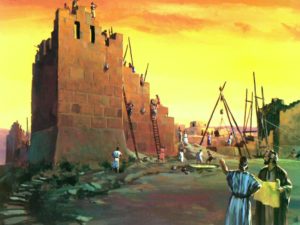In this lesson, we examine the first period of Old Testament history found in Genesis chapters 1-3. These three chapters are jam packed, so hold!
Why Genesis? This is a fair question to start with. Realize, there were no atheists alive when Moses wrote Genesis, though there were pools of polytheists (those who believe in many gods). Many scholars compare the Genesis creation story to its contemporary pagan stories of beginnings. Bruce Waltke quips, “Faced with this threat of paganism, politically redeemed Israel needed a creation narrative because they were in need of spiritual redemption. They not only needed political redemption from slavery under Pharaoh; they needed to be cleansed from their pagan contamination. ” Consider how easy it is for you to forget whose creation you are. Israel was no different.
Why Genesis 1-3? If you are not keen to the organization of Genesis, you might ask this question. Here is a brief explanation. Within Genesis 1-3 there is a cycle that occurs- Creation (Ch. 1-2), Fall (Ch. 3), and Redemption (3:15, v. 21). ![[Tags] 4-part-redemption-300x101 Lesson 1- What You Need to Know About the Beginning Period](https://fiveminutebiblestudy.com/wp-content/uploads/2018/01/4-part-redemption-300x101.jpg) This microcosmic cycle proves repetitious by the conclusion of Malachi. In fact, this same cycle repeats itself no sooner than with the story of Noah (Genesis 5:28 – 9:29). The point is this: Genesis 1-3 condenses all 66 books of the Bible into a 15 minute read. Christ is at the center. All things in this universe, from beginning to end, find their significance in Christ, the Seed of Eve (Gen. 3:15).
This microcosmic cycle proves repetitious by the conclusion of Malachi. In fact, this same cycle repeats itself no sooner than with the story of Noah (Genesis 5:28 – 9:29). The point is this: Genesis 1-3 condenses all 66 books of the Bible into a 15 minute read. Christ is at the center. All things in this universe, from beginning to end, find their significance in Christ, the Seed of Eve (Gen. 3:15).
What You Need to Know-
Genesis 1 was not written to disprove evolution. It was more likely written to elicit the raw power of Yahweh that breathed the universe into existence (1:6), thus, establishing His dominion and reminding Israel of their place within that dominion. This is the very almighty Yahweh who memory impaired Israel kept forgetting while making golden calves for worship (Exodus 32) and prostituting with Moabite whoremongerers (Num. 25). Yahweh is eternal. He has the power to rule and the love to create. Genesis 1 secondarily introduces Yahweh’s vice regent…man. The final day of creation is dedicated to a creature made in God’s image (lit.- “something cut from an object”). God saw fit to give this particular soul wielding creature the right to rule over His creation (Gen. 1:26-28).
Genesis 2 is not a second creation, and neither was this chapter composed by some author different from Moses. Naturalists and skeptics fantasize everything they can in effort to discredit the reliability of this historical, inspired document. As Victor Hamilton posits, “The order of events in Ch. 1 is chronological; the order of events in Ch. 2 is logical and topical, from humankind to its environment.” In this chapter, those things which God’s vice regent is to rule over are detailed. One special phrase in this chapter also provides introduction in how to read Genesis. In Genesis 2:4 the phrase, “This is the history of…” (NKJV) becomes a popular phrase. This entire phrase was originally one single Hebrew word toledoth, literally meaning “the generations of”. This phrase is used several times throughout the book to introduce genealogies (5:1, 6:9, 10:1, 11:10, 11:27, 25:12, 25:19, 36:1, 36:9, 37:2) and is posited to be the main transitional clause throughout Genesis. In other words, whenever you read this phrase, Moses is asking you to pay attention, because the story is taking a change.
Genesis 3 focuses on the fall and redemption of God’s vice regent. In another sense, Genesis 3 introduces the reader to a bloody war. The enemy is introduced as “the serpent”, otherwise familiar as Satan. Interestingly enough, Satan is a Hebrew word that simply means “adversary”. It is also a title. “Satan (the serpent) is not who he is, but what he is,” (Hamilton). This slimy adversary takes a bite at the apple of God’s eye- man. The blow the serpent inflicts will lead to perpetual pain and death for Adam, Eve, and all the generations that come from them (3:16-19). But before this single battle is ended, the God of Genesis 1:3 utters a death wish to His enemy. This brings the story to its climax in Genesis 3:15. This verse is traditionally called the first gospel (good news). For being such good news, it rings most dominantly of judgement. God, in booming speech says, “I will put enmity between you and the woman, and between your seed and her Seed…” The word enmity literally means “to be an enemy to” and is the first word of the sentence in Hebrew. God is putting emphasis on His judgment, and this judgment is a death threat to Satan. The word seed is literally translated sperm, denoting the fact that, future battles will come between the offspring of Satan and Eve. But don’t worry, though the serpent’s offspring will inflict a flesh wound on the Seed of Eve, the Seed of Eve will strike a death blow to the head of the serpent’s seed.
The Significance– Christ is the Seed of Abraham, the Seed of Eve (Galatians 3:16). Many battles take place between Satan’s seed and Eve’s seed while reading the pages of the Old Testament (i.e. David and Goliath, Samson and the Philistines, etc.). But John says the ultimate battle took place when Christ came, “He who sins is of the devil, for the devil has sinned from the beginning. For this purpose the Son of God was manifested, that He might destroy the works of the devil.” Christ’s heel was bruised on the cross, but Satan’s head was crushed by the resurrection. Creation, Fall and Redemption- this is the message of Genesis 1-3. This is the message of the Bible.
Helpful Resources- 1) A Biblical-Theological Introduction to the Old Testament by Miles V. Van Pelt 2) Handbook on the Pentateuch by Victor P. Hamilton 3) The Christ of History by Sinclair Ferguson



